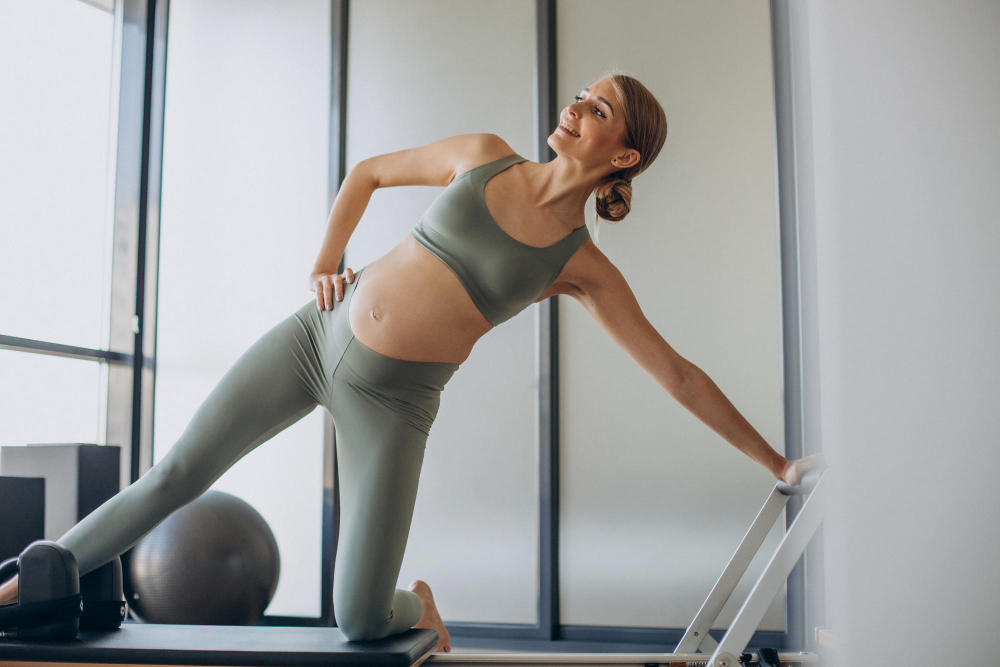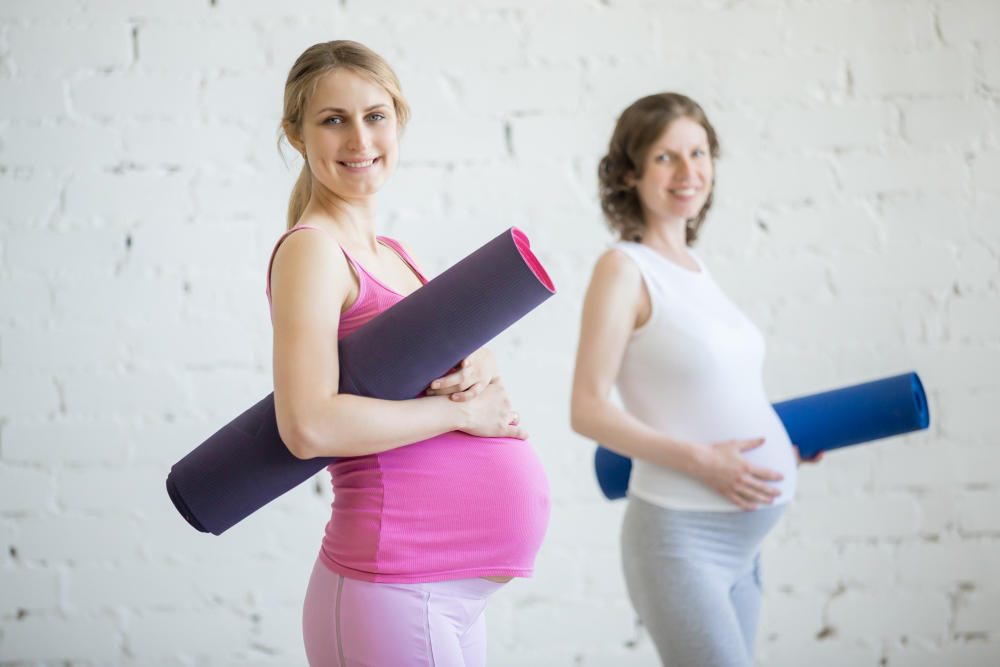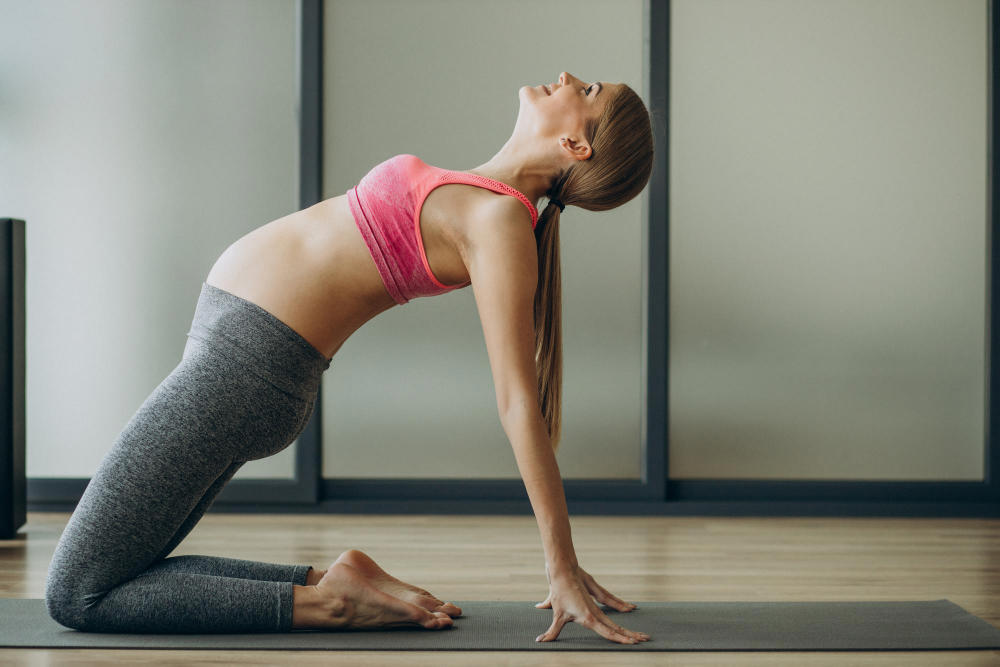Pilates is a versatile exercise developed by Joseph Pilates. The origins of Pilates began during his time in the internment camp, where he started creating the floor routines that later progressed into the Pilates mat exercises we are familiar with today.
The workout aims to improve posture and movement. The movements focus on the lower abdominal, pelvic floor, and back muscles, which are crucial for posture, strength, and balance. While it is often grouped together with yoga, Pilates and yoga are different.
The exercises can be done on a mat or using equipment such as a reformer, trapeze table, exercise ball, and resistance band. Pilates combines flexibility and strength training with body and mind awareness, providing excellent benefits even during pregnancy.
Pregnancy can cause a loss of control over one's body as it undergoes constant growth and change, often leading to discomfort. Engaging in physical activity can help re-establish a connection with one's body and provide advantages for both the mother and baby.
As the complexity of positions and movements in Pilates increases, you may be concerned about whether practicing during pregnancy is safe. However, with guidance from your doctor and exercise modifications, Pilates can still be a beneficial and safe workout during pregnancy.

What Does "Prenatal Pilates" Mean?
Prenatal pilates is a set of exercises specifically tailored for pregnant women to help them build strength, improve flexibility, and aid in postpartum recovery. These classes exclude any movements that could potentially harm a pregnant woman's body and instead incorporate modified exercises and stretches that are safe for them.
Pregnant women can incorporate prenatal pilates into their exercise routine to maintain good physical health. The classes are gentle and do not involve high-impact movements, instead focusing on strengthening all muscle groups that can help manage pain during pregnancy. Additionally, improved flexibility and mobility can help women resume physical activity after giving birth.
Is it Safe?
Many expectant mothers are concerned about the potential risks of exercising during pregnancy. However, Pilates is a gentle and effective exercise that targets the muscles most impacted by pregnancy.
According to research, engaging in physical exercise during a healthy pregnancy poses little to no risk. Pilates, which emphasizes low-impact movements and joint stabilisation, can effectively manage or eliminate common pregnancy-related discomforts.
Its low-impact nature enables practitioners to perform exercises without putting undue stress on their backs or joints, making it a safe option for pregnant women. Additionally, strengthening the core and pelvic floor muscles through Pilates can lead to a smoother pregnancy, delivery, and postpartum recovery.
However, seeking advice from a prenatal healthcare professional before starting or continuing any exercise program while pregnant is essential. Certain conditions, such as heart and lung issues or other conditions leading to preterm labor, may categorize a pregnancy as high-risk. In such cases, it's likely that exercise will not be recommended or may even be unsafe.

How Can Pilates Help in Pregnancy?
Pilates can enhance the strength of your abdominal, back, and pelvic floor muscles, which are the regions that may pose difficulties during pregnancy and postpartum. Therefore, it is an ideal workout to engage in while pregnant, although certain exercises may require modifications as your due date approaches.

Consistently practicing Pilates can provide many benefits. The strength of your abdominal muscles will be enhanced, which can better equip your body to handle the strains caused by the increasing weight of your growing baby. During pregnancy, hormones can make the ligaments that connect your bones more flexible, increasing the risk of injury.
Pilates also strengthens your pelvic floor muscles, supporting your bladder, bowel, and uterus as your baby develops and moves downward. This can prevent you from experiencing urinary incontinence when coughing or sneezing and help you push your baby out during delivery.
You can alleviate back pain by exercising the abdominal muscles that stabilize your back and pelvis. Strengthening these muscles can help reduce discomfort in your back or pelvis.
Improving your balance is another benefit of Pilates, which strengthens your core and makes you more stable as your baby bump grows. This can be especially helpful if you feel clumsier than usual during pregnancy.
Furthermore, Pilates relieves the strain on your back and pelvis by using positions such as going on your hands and knees, which can alleviate pregnancy-related back pain.
Tips to Safely Practice Pilates Safely During Pregnancy
Although pilates is generally a low-impact exercise suitable for most people, there are a few things to remember when exercising while pregnant.
Working with a certified instructor is recommended to maximise your pilates workout and ensure your safety. Seeking out a pregnancy-specific class or a one-on-one instructor can be an excellent place to start.
Inform your instructor that you are pregnant before beginning the class. They should be able to modify the exercises to suit your changing body throughout each stage of your pregnancy.
Due to the shift in your center of gravity during pregnancy, you may be more prone to losing balance. It's recommended to move slowly and use support, such as a wall or chair.
If you have any specific conditions during pregnancy, such as pelvic girdle pain (PGP)/symphysis pubis dysfunction (SPD), or diastasis recti, follow your teacher's advice on which exercises are appropriate.
Avoid pilates that involves heat, and stay cool during your workout. Be mindful not to overstretch or push yourself too hard. It's essential to exercise caution because your body generates a hormone called relaxin during pregnancy, which softens the tissue between your joints and increases your risk of injury.
If lying on your front is uncomfortable, use pillows to support your body or perform the exercise on your hands and knees. Avoid lying on your back for extended periods, particularly after 16 weeks of pregnancy.
Remember to breathe deeply and evenly throughout the exercises and avoid holding your breath. Stop exercising immediately if you feel dizzy, out of breath, or experience any pain.
Did you know that Pilates is suitable for all? Click here to read Pilates for Men.
Practicing Pilates Over Three Trimesters
The body undergoes constant changes during the nine or more months of pregnancy. There are days when getting out of bed is a struggle, and one may have to rely on a diet of saltines. On other days, there may be bursts of energy and a sudden craving for something unusual like tuna fish and chocolate milk.
Similar to the body's changes, the prenatal Pilates practice should also adapt. The expansion of the uterus causes a constant shift in the body's center of gravity, and there are changes in how one feels.
While your prenatal Pilates workout aims to attain balanced muscle development, stability, and body awareness, paying attention to your body and making modifications as necessary is crucial.
First Trimester
It is generally safe to continue with any pre-existing workout routine during the first trimester of pregnancy. However, it is crucial to reduce the intensity of the workout to avoid elevating body temperature and heart rate, as this trimester carries the highest risk of miscarriage. Additionally, it is recommended to engage in pelvic floor muscle activation exercises.

Some exercises that can be done in this trimester are Leg lifts, hip rolls, and bent knee fallout. If comfortable with these Pilates moves, they can be continued throughout the pregnancy as they are safe for all trimesters.
Second Trimester
To maintain physical fitness during pregnancy, continuing with prenatal exercises into the second trimester is recommended. If comfortable, Pilates exercises performed during the first trimester may be continued, except for abdominal work. This is to prevent the tightening of the rectus abdominus muscle while the belly grows, which could increase the risk of diastasis recti.
Several Pilates exercises are beneficial during the second trimester, especially as the body experiences growing pains due to the accelerated growth of the belly and the baby. Some exercises that can be done in this trimester are squatting side bends, spine twist, and side plank.
Third Trimester
Women often feel weighed down, uncomfortable, and eager to give birth in the third trimester. Additionally, the baby's growth can cause significant changes in the mother's posture.
It is safe to continue exercising up until the day of delivery. Still, it is crucial to be mindful of the body's signals and only engages in exercises that feel comfortable and align with exercise guidelines.
During this trimester, it is advisable to avoid all abdominal and inner thigh work and the supine lying position. Some exercises that can be done in this trimester are cat/cow with band and mermaid.
Pilates After Pregnancy
After giving birth, the postpartum period is characterized by significant physical and emotional changes. As your body and mind adapt to this new phase, incorporating exercise into your daily routine when you feel prepared can help improve your energy levels, flexibility, and strength. This can aid in restoring a sense of normalcy and help you feel more like yourself again.
Pilates is a gentle way to regain strength and fitness after pregnancy and can be particularly helpful due to its focus on strengthening the abdominal and core muscles. This is especially beneficial for women who have experienced abdominal separation after pregnancy, as Pilates moves can aid healing.
However, it is essential to consult with a doctor before starting any post-pregnancy exercise routine and to begin slowly. The body has undergone significant changes during pregnancy, and rebuilding strength will require time, effort, and patience. Pilates is an ideal starting point as it is low-impact and can be modified to suit individual needs.
Are you interested to learn Pilates? Find a reliable and highly experienced Pilates instructor with Superprof and start learning immediately!















